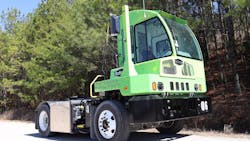Terminal tractors: A solid start toward zero-emission trucking
The future will include cleaner freight movement. But exactly what the power source of cleaner vehicles will be remains to be seen. Given traditional trade cycles and supply chain issues with getting new vehicles to fleets, it is likely that diesel-powered vehicles will be delivering freight for years to come.
However, fleets need to start exploring some of the other powertrain options. While change can be difficult, especially given the tight margins fleets are operating on, the industry needs to begin making steps toward a zero-emission future.
One place to start is with terminal tractors, which a North American Council for Freight Efficiency (NACFE) report lauds as an exceptional way for heavy-duty fleets to learn about and implement battery electric vehicles into operations. They are a good fit for the current state of battery-electric technology, as they travel a few miles a day, operate at low speed, stay close to a home base or remain in the fleet yard, and can plug into chargers when drivers are on break.
See also: Making the case for electric terminal tractors
While an electric terminal tractor costs more than its diesel-powered equivalent, there are incentives to help mitigate the cost difference. And the cost of battery packs continues to drop, meaning cost parity may be on the horizon.
It is easy for fleet managers and fleet maintenance managers to keep a close eye on their terminal tractors to check operational performance and get direct feedback from drivers. They can do all of this without having to worry about where and how the vehicles will charge—simply plug it into existing power at the yard.
See also: EVs are a perfect fit for commercial vans
A combination of regulatory and societal pressures is leading the trucking industry to consider ways to lower greenhouse gas emissions and reduce its carbon footprint. Switching to battery-electric terminal tractors allows fleets to learn about these vehicles and then apply the data to other vehicles in their operation.
Patrick Gaskins, SVP of Corcentric Fleet Solutions, oversees both sales and operations for the company's fleet offerings. Gaskins joined the company in 2010, bringing more than 30 years of experience as a financial services professional in the transportation industry. He leads a team that works with a supply base of more than 160 manufacturers to help the country’s largest fleets manage all aspects of their fleet operations and fleet-related spend.
About the Author

Patrick Gaskins
Senior vice president, Fleet Solutions
Pat Gaskins is the senior vice president of Corcentric Fleet Solutions, where he leads both the sales and operations teams for the company’s fleet offerings. He has over 30 years of experience as a financial services professional in the transportation industry and manages partnerships with over 160 manufacturers, helping over 2,000 of the country’s largest fleets manage all aspects of their fleet operations and fleet-related spend.
